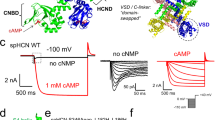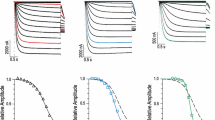Summary
Veratridine opens voltage-dependent Na+ channels in many metazoans. InParamecium, which has voltage-dependent Ca2+ channels and a Ca/K action potential, no such Na+ channels are known. A Ca-inward current is correlated to an intracellular increase in cGMP. The addition of veratridine toParamecium wildtype and to pawn mutant cells, which lack the Ca-inward current, transiently increased intracellular levels of cGMP about sevenfold to 40 pmol/mg protein. A half-maximal effect was obtained with 250 μm veratridine. The increase in cGMP was maximal about 15 sec after the addition of veratridine and declined rapidly afterwards. Intracellular cAMP levels were not affected. The effect of veratridine on cGMP was dependent on the presence of extracellular Ca2+. The time dependence and extent of stimulation closely resembled the effects observed after stimulation by Ba2+, which causes the repetitive firing of action potentials, Ca-dependent ciliary reversal, and cGMP formation. The effects of Ba2+ and veratridine were not additive. Wildtype cells and, surprisingly, also pawn mutant cells showed avoiding reactions upon addition of veratridine indicating that it induced a Ca2+ influx into the cilia, which causes ciliary reversal. The potency of veratridine to stimulate cGMP formation was little affected by Na+ in wildtype cells, three pawn mutant strains, and in the cell line fast-2, which is defective in a Ca-dependent Na-inward current. Divalent cations (Ca2+, Mg2+, and Ba2+) inhibited the effects the veratridine similar to metazoan cells. The results indicate that veratridine can open the voltage-operated Ca2+ channels inParamecium wildtype and, most interestingly, in pawn mutant cells. The pawn mutation is suggested to represent a defect in the activation of the Ca2+ channel. This explains the lack of differences in ciliary proteins between wildtype and pawn cells reported earlier.
Similar content being viewed by others
References
Adoutte, A., Ling, K.-Y., Chang, S., Huang, F., Kung, C. 1983. Physiological and mutational protein variations in the ciliary membrane ofParamecium.Exp. Cell Res. 148:387–404
Catterall, W.A. 1975. Activation of the action potential Na+ ionophor of cultured neuroblastoma cells by veratridine and batrachotoxin.J. Biol. Chem. 250:4053–4059
Delaage, M.A., Roux, D., Cailla, H.L. 1978. Molecular Biology and Pharmacology of Cyclic Nucleotides. G. Falco, R. Paoletti, editors. pp. 155–170. Elsevier, Amsterdam
Dunlap, K. 1977. Localization of calcium channels inParamecium caudatum.J. Physiol. (London) 271:119–133
Hille, B. 1984. Ionic Channels in Excitable Membranes. Chap. 16. Sinauer Associates, Sunderland, Massachusetts
Hinrichsen, R.D., Saimi, Y., Kung, C. 1984. Mutants with altered Ca2+, characterization and genetic analysis.Genetics 108:545–558
Hinrichsen, R.D., Schultz, J.E. 1988.Paramecium: A model system for the study of excitable cells.Trends Neurosci. 11:27–32
Klumpp, S., Schultz, J.E. 1982. Characterization of a Ca2+-dependent guanylate cyclase in the excitable ciliary membrane fromParamecium.Eur. J. Biochem. 124:317–324
Kung, C., Saimi, Y. 1985. Ca2+ channels ofParamecium: A multidisciplinary study.Curr. Top. Membr. Transp. 23:45–66
Leibowitz, M.D., Sutro, J.B., Hille, B. 1986. Voltage-dependent gating of veratridine-modified Na+ channels.J. Gen. Physiol. 87:25–46
Ling, K.-Y., Kung, C. 1980. Ba2+ influx measures the duration of membrane excitation inParamecium.J. Exp. Biol. 884:73–87
Merkel, S.J., Kaneshiro, E.S., Gruenstein, E.I. 1981. Characterization of cilia and ciliary membrane proteins of wildtypeParamecium tetraurelia and a pawn mutant.J. Cell. Biol. 89:206–215
Ogura, A., Machemer, H. 1980. Distribution of mechanoreceptor channels in theParamecium surface membrane.J. Comp. Physiol. 135:233–244
Ogura, A., Takahashi, K. 1976. Artificial decilistion causes loss of calcium-dependent responses inParamecium.Nature (London) 268:170–172
Saimi, Y. 1986. Calcium-dependent sodium currents inParamecium: Mutational manipulations and effects of hyper- and depolarization.J. Membrane Biol. 92:227–236
Saimi, Y., Hinrichsen, R.D., Forte, M., Kung, C. 1983. Mutant analysis shows that the Ca-induced K+ current shuts off one type of excitation inParamecium.Proc. Natl. Acad. Sci. USA 80:5112–5116
Saimi, Y., Kung, C. 1987. Behavioral genetics ofParamecium.Annu. Rev. Genet. 21:47–65
Satow, Y., Kung, C. 1980. Membrane currents of pawn mutants of the pwA group inParamecium tetraurelia.J. Exp. Biol. 84:57–71
Schultz, J.E., Pohl, T., Klumpp, S. 1986. Voltage-gated Ca2+ entry intoParamecium linked to intraciliary incrase of cyclic GMP.Nature (London) 322:271–273
Schultz, J.E., Schade, U. 1989. Calcium channel activation and inactivation inParamecium biochemically measured by cyclic GMP production.J. Membrane Biol. 109:259–267
Takahashi, M., Haga, N., Hennessey, T.M., Hinrichsen, R.D., Hara, D. 1985. A gamma ray-induced non-excitable membrane mutant inParamecium caudatum: A behavioral and genetic analysis.Genet. Res. 46:1–10
Thiele, J., Honer-Schmid, O., Wahl, J., Kleefeld, G., Schultz, J.E. 1980. A new method for axenic mass cultivation ofParamecium tetraurelia.J. Protozool. 27:118–121
Thiele, J., Otto, M.K., Deitmer, J.W., Schultz, J.E. 1983. Calcium channels of the excitable membrane fromParamecium: An initial biochemical characterization.J. Membrane Biol. 76:253–260
Ulbricht, W. 1969. The effect of veratridine on excitable membranes of nerve and muscle.Ergeb. Physiol. Biol. Chem. Exp. Pharmakol. 61:18–71
Author information
Authors and Affiliations
Rights and permissions
About this article
Cite this article
Schultz, J.E., Schade, U. Veratridine induces a Ca2+ influx, cyclic GMP formation, and backward swimming inParamecium tetraurelia wildtype cells and Ca2+ current-deficient pawn mutant cells. J. Membrain Biol. 109, 251–258 (1989). https://doi.org/10.1007/BF01870282
Received:
Revised:
Issue Date:
DOI: https://doi.org/10.1007/BF01870282




